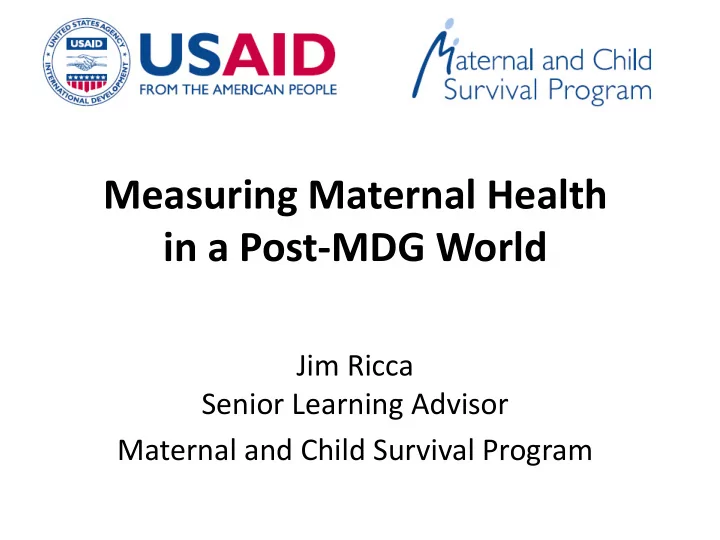

Measuring Maternal Health in a Post-MDG World Jim Ricca Senior Learning Advisor Maternal and Child Survival Program
What do we measure now? Global benchmark indicators • Skilled birth attendance • Antenatal Care attendance (1,2,3,4 visits)
Contrast with child health benchmark indicators
Why contact indicators are problematic • Harvey S, et. al.(2007), Are skilled birth attendants really skilled?, WHO Bulletin, 85 (10):783-790 • Souza JP, et. al. (2013), Moving beyond essential interventions for reduction of maternal mortality (the WHO Multicountry Survey on Maternal and Newborn Health): a cross-sectional study, Lancet, 381: 1747 – 55
MMR vs SBA% Asia 30 countries with 90% of deaths globally Africa China 100 South Africa 90 80 Indonesia DRC SBA % 70 Burkina Faso Malawi 60 50 40 30 Bangladesh 20 10 Afghanistan Ethiopia 0 -400 100 600 1100 1600 MMR
Possible sources for more robust (“content”) data • Secondary data sources – National household surveys (DHS, MICS) – National facility assessments (SPA, SARA, others) • Health Management Information System (HMIS), i.e., routine information
Are household surveys the answer? Measuring Coverage in MNCH: Testing the Validity of Women’s Self-Report of Key Maternal and Newborn Health Interventions during the Peripartum Period in Mozambique C. Stanton, B. Rawlins , M. Drake, M. Dos Anjos, L. Chavane, D. Cantor, M. Vaz, L. Chongo, J. Ricca
Study design to test maternal recall Step 1: Observe Labor & Delivery Care (525 labors/births observed in 46 facilities across MZ in Quality of Care Study) Step 4: Compare, Step 2: Wait determining validity for 8-10 months of respondents’ reports Step 3: Conduct household interviews 1) Standard DHS/MICS questions 2) Additional questions
Few indicators met validity criteria Individual Population INDICATOR Accuracy Accuracy Woman delivered in a hospital + + versus a health center Woman had a companion present during the + + labor or delivery Newborn is placed skin to skin on mother's chest + +
Facility Assessments – “readiness - quality gap” 100 90 80 70 60 Unexplained 50 SBA not present Commodity not present 40 Women who received the intervention 30 20 10 0 Infection prevention Partograph used Oxytocin use in third Magnesium sulfate Cord cut with clean during initial during labor stage of labor use for PE/E instrument assessment
HMIS as a possible source of data PROS • Readily available • Regularly reported • Promotes good habits of data use CONS • Incomplete and inaccurate reporting • “Incomplete picture” – only public sector facilities
Promising Approaches METHODS : Possible need for novel approaches • Linked facility-population surveys CONTENT: Simple but meaningful indicators • Late stillbirth + Very Early Newborn Deaths • Uterotonic in third stage of labor • Prolonged labor • MgSO4 for PE/E • C section rate (?) • Partograph use (?) • Components of ANC / PPC
Recommend
More recommend